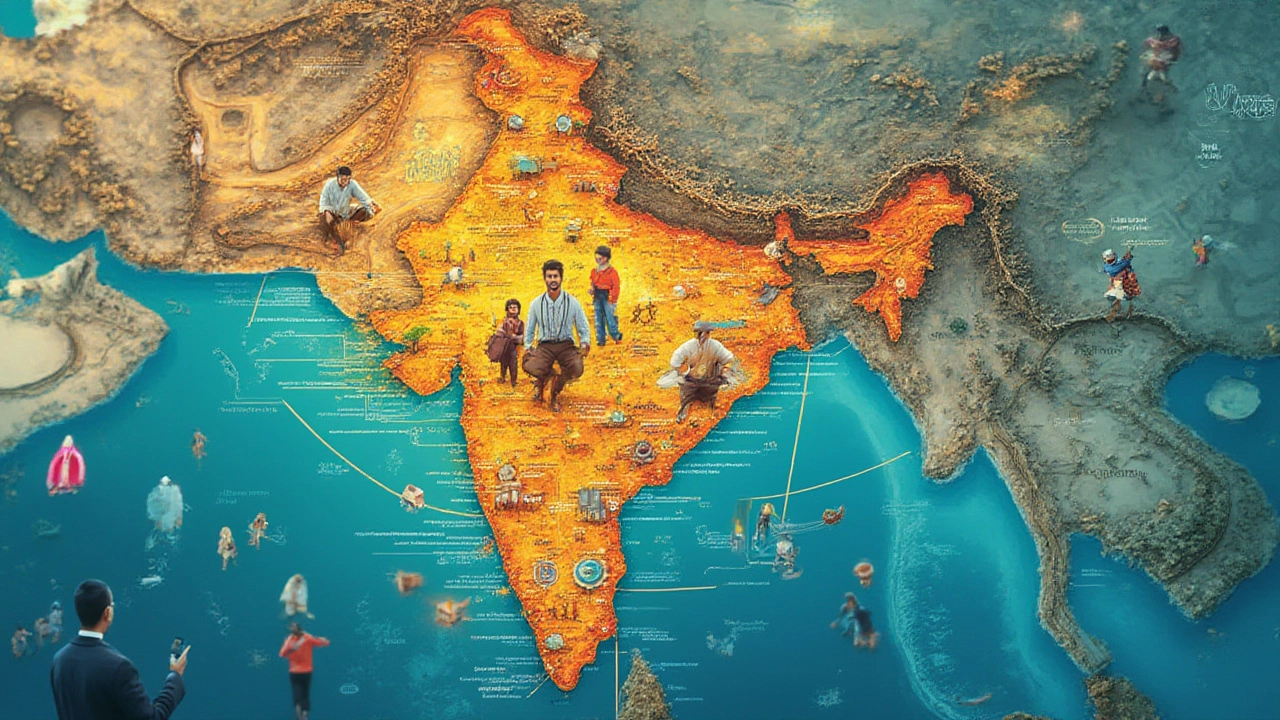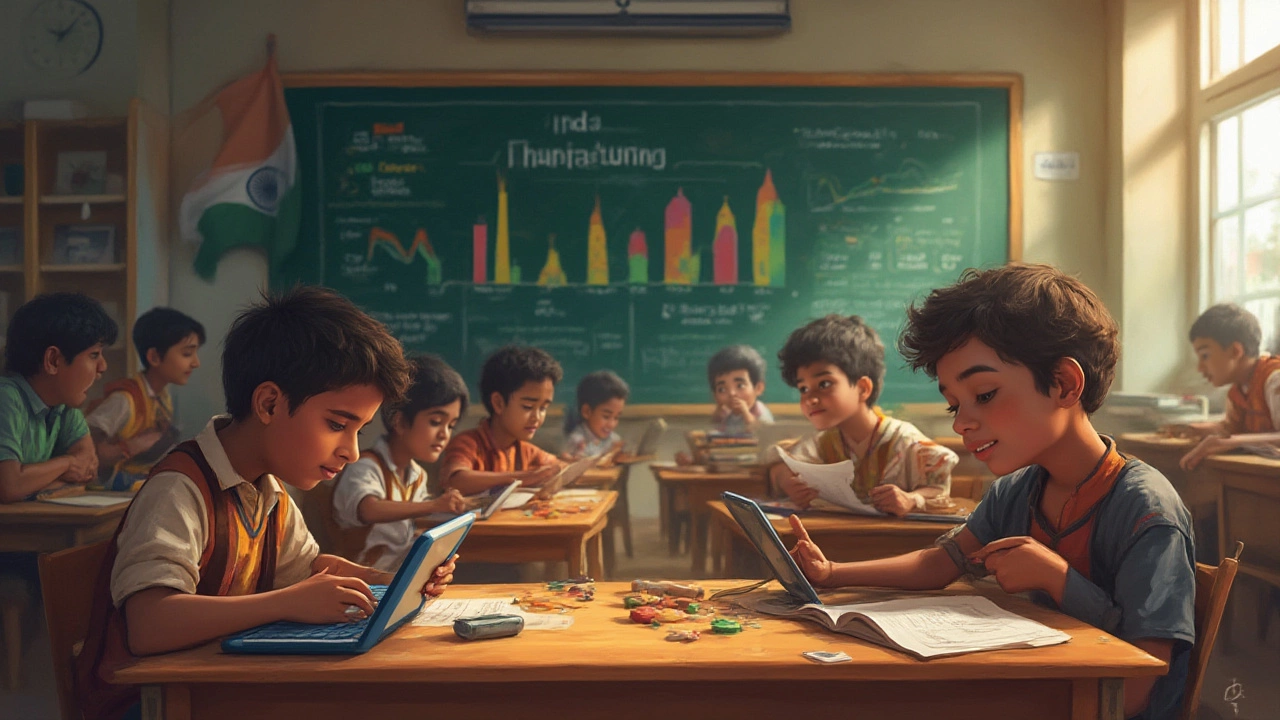 Jul, 29 2025
Jul, 29 2025
Ever wonder how India stacks up on the global stage? For folks who only catch headlines now and then, it's easy to miss just how much India has been hustling its way up the ranks. The world's most populous democracy is no longer just known for Bollywood and spicy food—it's shaking up the global order in some pretty unexpected ways. Whether you're dreaming of launching a new product, weighing investment opportunities, or just keeping an eye on world trends, knowing where India stands lets you read the room, and maybe, spot the next big thing before your neighbors do.
India's Place in the Global Economy
When you peek at any top-10 list for the world economy, India’s name pops up with an exclamation mark. As of July 29, 2025, India ranks fifth in terms of nominal GDP, sitting comfortably ahead of countries like the UK and France, but just behind economic giants like the US, China, Japan, and Germany. Here's a quick snapshot:
| Country | Nominal GDP (USD Trillion, 2025 est.) | Rank |
|---|---|---|
| United States | 28.2 | 1 |
| China | 18.7 | 2 |
| Japan | 4.8 | 3 |
| Germany | 4.7 | 4 |
| India | 4.4 | 5 |
India's economic growth isn’t just fast—it often tops the G20 charts, averaging a 6-7% GDP growth rate over the last few years. That’s wild in a world where many countries are happy with 2% growth. What’s fueling this? A young, working-age population (median age is just over 28), technology investments, and a government that isn’t shy to roll out big infrastructure projects. In terms of purchasing power parity (PPP)—which balances currency differences—India leapfrogs to third place globally, right behind the US and China.
But it’s not all roses. The per capita income is still much lower than in most Western countries, which can skew the experience for most Indians. Still, the country has become a massive market for smartphones, streaming, EVs, and more—you name it. If you follow the Indian middle class, you can often predict global consumer trends three years out.
Manufacturing: The Engine of India's Climb
It might surprise you, but India is the sixth largest manufacturer in the world—nipping at the heels of South Korea, and leaving the UK and France further behind. This wasn't always the case. Ten years ago, almost everything techy or fancy had a Made in China label. In 2025, it’s a toss-up between China and India in categories like chemicals, textiles, pharmaceuticals, and—this one’s fun—electric vehicles.
The government’s 'Make in India' push started with a splashy launch in 2014, but the real action happened in the 2020s. Lower corporate taxes, easier customs, incentives for chip plants, and new labor rules kicked open the doors for investments. Apple, Samsung, and Foxconn keep shifting their phone assembly to southern India. New auto plants churn out both two-wheelers and electric cars at rates never seen before. Classic family-run textile mills in Tamil Nadu have gone global, exporting fashion basics to companies like H&M and Zara. If you own a ‘generic’ paracetamol tablet, there’s about a 1 in 3 chance it came out of an Indian plant. Indian pharma is not just a supplier for the “global south”—it’s now a critical cog in the supply chain for Europe, the US, and beyond.
Numbers tell this story best. India’s manufacturing sector accounted for about 17.7% of its GDP in 2025 (as per the Ministry of Commerce and Industry’s mid-year report), and is growing at a rapid clip. Even small towns are turning into hubs for plastics, steel, and auto components. The country now exports to more than 200 destinations worldwide. The government’s aim? To hit 25% of GDP from manufacturing by 2030. The floor is rising fast, and it’s pushing up thousands of small businesses along with the big players.

Tech, Innovation, and Skill: India's Soft Power
Want to see where India quietly punches way above its weight? Look at the tech sector. The country's IT exports for 2024-2025 touched a record $274 billion, according to NASSCOM, making it the world's largest outsourcing destination. But it’s not just call centers anymore. Indian software firms are now building code for driverless cars, AI platforms, fintech, and the next-gen chips sitting inside your favorite gadgets.
Startups are mushrooming everywhere—in 2025, India became only the third country (after the US and China) to boast over 100 unicorns (startups valued at more than $1 billion). Bangalore, Hyderabad, Pune, and Gurugram have their own flavor of tech valleys. The government’s push for digital payments and unified digital IDs made India the largest real-time payments market worldwide, with over 130 billion UPI transactions recorded in just the past year.
India also comes in as the world's largest producer of engineers—over 1.5 million engineering graduates pass out every year. From CEOs at Google, Microsoft, and Adobe, to independent developers launching successful apps, Indians are everywhere in the tech value chain. India’s space program, ISRO, wowed the world in August 2023 by landing Chandrayaan-3 on the moon’s south pole—something even NASA hadn’t done yet. That single event fired the imagination of a generation and made India more than just a ‘back office’ in global R&D circles.
Social Development: Health, Education, and Human Potential
The bright economic stats look different when you zoom into health, literacy, and quality of life. Here, India still has a long climb. Its Human Development Index (HDI) placed it at 132nd out of 191 countries in 2025—much lower than its economic weight would suggest. Average life expectancy is up to 71.4 years, but still lags behind Asian neighbors like Sri Lanka or China. Literacy rates crossed 80% for the first time, but the quality of schooling swings wildly between cities and rural areas.
Healthcare is improving, but out-of-pocket costs remain high for most families. India has made big leaps in eradicating polio, cutting malnutrition, and expanding insurance coverage, but rural clinics are often under-staffed. Then again, the country minted more nurses and doctors in the last five years than much of Western Europe—a sign of where priorities are shifting. Big city hospitals now offer world-class treatment, attracting 'medical tourists' from Africa, the Gulf, and beyond.
In education, the government’s new National Education Policy is chipping away at old rote learning, pushing for digital classrooms and more hands-on skills. India’s edtech firms, like BYJU’S and Unacademy, are household names across Asia and Africa. No other country has so many K-12 students in online learning—they hit 80 million in 2025. Of course, challenges remain: overcrowded public schools and steep divides between rich and poor districts. But the direction is pretty clear—upward, and fueled by youth.

India's Role in Global Trade, Diplomacy, and Environment
India is not the shy kid in the corner anymore. In 2025, it's leading the Global South’s push for fairer trade and tech access, and elbowing for a permanent seat on the UN Security Council. India is now the world’s second-largest food producer and fastest-growing exporter of digital services. When the rare earth race got hot, India began mining and exporting more to meet global demand for green tech, including the batteries in electric cars and solar panels.
Diplomatically, India has pulled off a clever balancing act: partnering with the US, talking business with the EU, managing old-school rivalry with China, and keeping strategic ties with Russia and the Middle East. The rise of Quad (with Japan, the US, and Australia) shows how India is shaping new Asian security networks. Even when you look at vaccines—India delivered over 250 million doses abroad during the COVID crisis, earning global goodwill (and a bit of soft power, too).
On the environmental front, India set a goal to hit net-zero emissions by 2070, and is rapidly scaling up solar and wind energy. In 2025, it ranked third for total renewable energy capacity, right after China and the US. Pollution is still a huge problem—go to Delhi in November and you’ll see—but the shift to electric vehicles and green tech is visible on every street. Exports of eco-friendly textiles, biodegradable plastics, and sustainable food products shot up 30% last year. That’s a real-world sign things are heading the right way.
Sizing up India’s place in the world is honestly like trying to pin down a river’s path—it twists, turns, and never quite stays the same. But here’s the vibe everyone’s feeling: India isn’t asking for a place at the table anymore; it’s rearranging the seats.